A Nutritionist’s Approach to Summer Heat
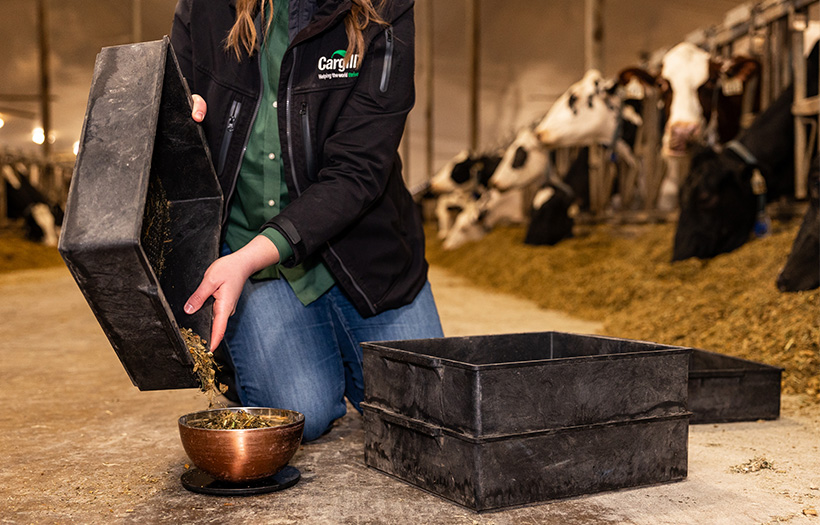
As a nutritionist, continually evaluating the dairy ration and cow comfort is critical to maintaining a producer’s production goals, especially in hot summer months. CowSignals, a program developed by veterinarian Joep Driessen and his team in the Netherlands, includes tools to monitor and evaluate the six essential aspects of cow comfort: feed, light, water, rest, space and air. Highlighted here are relevant examples of producers and nutritionists who used diet and comfort to yield positive results under challenging heat stress conditions.
Nutrition and technology
Monitoring dry matter intake (DMI) during heat stress periods is important to manage cows’ forage and energy requirements. Cows consume their total daily DMI in 10 to 12 feedings per day. To maintain rumen pH stability, consistent access to the ration is important. To achieve this consistency, the ideal feedbunk space for a lactating cow is 27 inches and 30 inches for the transition cow, according to the CowSignals approach.
Feedout is recommended twice daily for freshness along the entire feedbunk, maximizing high-traffic areas. Feed push-ups are recommended every 30 minutes after feedout for two hours and every two hours thereafter to ensure ideal feed intake.
Managing group densities to achieve these recommendations additionally allows for cows to dissipate heat effectively during the warm season. In heat stress periods, cows will strategically consume feed in cooler periods of the day or night, leading to potential slug feeding.
Alternatively, cows will reduce total DMI, leading to both lower milk production and butterfat. I consider increasing energy density of the ration to maintain energy requirement and body condition score (BCS), always keeping in mind that energy-dense ingredients such as concentrates have a negative impact on rumen stability.
Adding bicarb and minerals to balance for higher DCAD are feeding strategies that must be considered.
The Penn State shaker box and rumination count are two on-farm tools I used to establish fibre length and maximize rumination. In addition to prevent sorting, these help measure good fibre mat in the rumen. It is important to keep historical data for each herd.
Figures 1 and 2 (page 26) show results from a 220-cow robot herd.
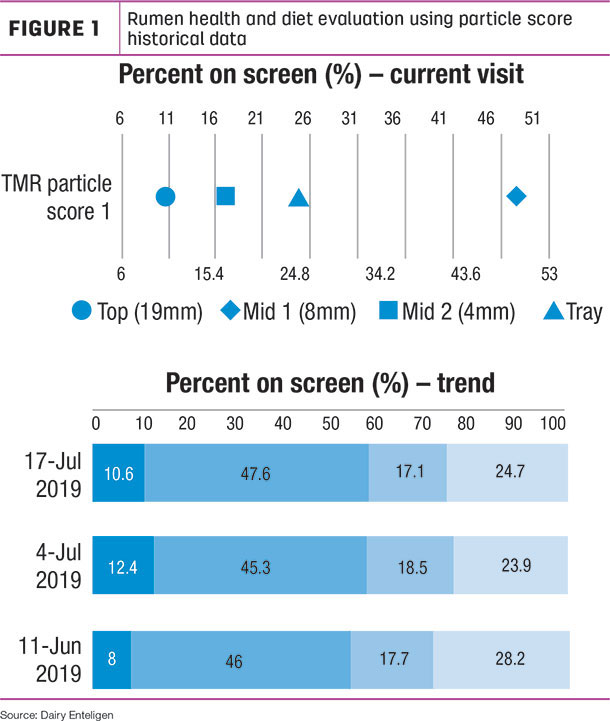
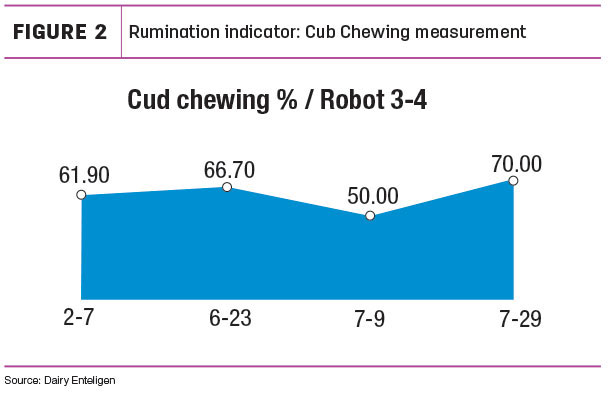
The Penn State box adjustments in Figure 1 were made early in July following the reduction noted in rumination measured using cud chewing observations shown in Figure 2. The ration was evaluated both chemically, to increase energy, and physically, using chop length tools, to minimize the drop in BCS over the summer (Figure 3, page 27), resulting in consistent annual milk production (plus or minus 1L, plus or minus 0.1% BF).
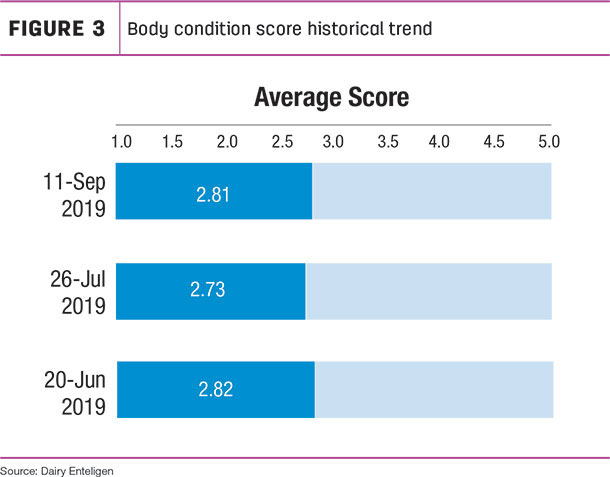
In the summer, many factors can result in higher locomotion score, including cows perching for longer periods of time, increased humidity, higher moisture from increased urination or sprinkler or mister systems, etc. Maintaining historical data of the herd’s yearly lameness percentage allows for comparison and were implemented in early summer months of 2019, resulting in improved locomotion score despite increased heat.
To counter the negative impacts of heat stress on reproduction, I recommend the use of a cooling pack including a source of osmolyte in the dairy ration. Osmolytes are designed to support hydration of the cells. By positively impacting water absorption in the cell of the animal, this type of product helps optimize her metabolism. However, osmolytes are only effective if cows have free access to water.
Figure 5 shows a 90-cow tiestall herd that used a cooling pack during the 2019 summer and had not the previous year. The cooling pack showed to improve pregnancy rate in the 2019 summer compared to the previous year. Milk output was greater and more consistent in summer 2019 versus previous years.
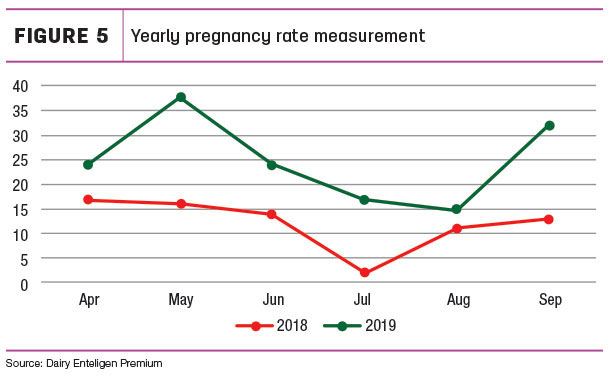
Environment
As we know, light plays an important role in DMI, reproduction and working environment. With a lux meter, light can be measured in your barn to evaluate if the 200-lux target for 16 to 18 hours per day is achieved. Putting lights on timers to maximize morning and evening light is key. Summer months are positively correlated with reproduction due to increased daylight hours and vitamin D exposure (dependent on barn layout). The three tools I use to evaluate water access are a measuring tape, a stopwatch and a volumetric pail. The recommended inches of clean water space per cow is 4 linear inches and a minimum 3 inches. Water flow target should be 16 to 20 litres per minute to satisfy cow drinking habits. Algae growth will be increased in summer compared to winter months; therefore cleaning and scrubbing water troughs daily is recommended. Hide a brush under the water trough float for easy access.
After walking a barn and finding below average water accessibility, I recommended the installation of additional water bowls adjacent to the feed fenceline. This investment resulted in a significant increase in return over feed, which has maintained throughout the year. Cows will stand or perch for longer periods of time when barn temperature is elevated in order to dissipate heat. Cows should lie down for a minimum of nine hours per day and, for every additional one hour of lying time, we can see gains of 1.5 litres of milk. I evaluate the percentage of cows lying down in a herd at different times of the day to evaluate if lying times are maximized. If not, stall dimensions are measured, taking out that measuring tape again. If you see congregation in the herd, this may be the reason for the lower lying time.
I evaluate wind speed via a wind meter and calculate the economics of installing extra fans to allow for proper herd dispersion. Fans should be installed above the cows to create an air exchange flow, not simply to circulate the air. Recommended wind speed is 8 kilometres per hour for fly control to help minimize udder health issues as well as to dissipate heat and humidity.
In a new, bedded-pack 60-cow robot start-up, cows kept congregating under fans, limiting visits to robots and the feed fence. After barn design and wind speed evaluations in August 2019, the door located at the end of the barn was closed to create a better air flow and cyclone fans were adjusted. Following this change, DMI increased by 0.4 kilogram, and robot flow was significantly improved.
Conclusion
Working with your nutritionist is key to maximize your success and your herd’s profitability in the summer months. Environment and a balanced ration go a long way in ensuring yearround consistent performance. Relying on your nutritionist to bring the tools necessary to evaluate cow comfort and optimize the diet based on seasonality will ensure the resilience of your herd over time. Measure it to validate the improvements. Amelie Mainville is a CowSignals master trainer. References omitted but are available upon request.
